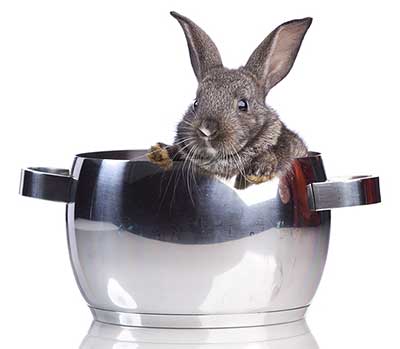
One of the most frequently underappreciated and scorned meats is that of rabbit and hare.
Too many people are quick to state how the meat is dry, stringy, tough, or tastes “gamey.” Yet these same people are also just as quickly to point out that they’ve never eaten rabbit or hare!
So, why the strong opinion on how rabbit and hare do or do not taste when they have no idea one way or the other? Your guess is as good as mine.
My own experience shows that rabbit and hare are one of nature’s greatest delicacy and a real treat for the hunter who isn’t too proud to bring in small game for food. With proper cooking, the meat is soft, amazingly tender, falling off of the bone and melting in your mouth. It’s also a flavorful meat, not “gamey” but having a rich and meaty taste that is very satisfying. It’s also a leaner meat and a healthier option that factory farmed pork or beef.
Cooking Rabbit vs Hare
There are a few differences when comparing rabbits to hare.
Firstly, these are two very different animals. They may look similar, but they are separate species with differences in behavior and range. As such, their meat is also different.
Hares are entirely dark meat and do well with longer cooking time. Rabbits, on the other hand, can be cooked much faster, with fresh rabbit frying up beautifully. Both rabbit and hare can be cooked together without any ill effects to either or noticeable taste difference in the finished dish.
Getting Started
After you’ve successfully brought in a rabbit or hare, you need to get to work skinning and gutting it as soon as possible. The longer you wait, the more difficult it becomes and the greater the chances the meat becomes contaminated by feces and urine –rendering it inedible.
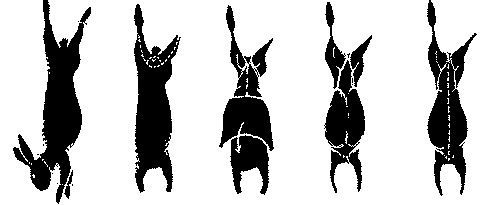
Skinning
Skinning is a simple process. You can either take your knife and cut up along the belly of the creature, cutting the back legs from the ankles to just above the anus. Pull the hide up carefully with your fingers, pulling at the hide at the ankles where it will tear and release the feet. From there, pull up and toward the head, cutting the hide up behind the ears (unless you want to skin the head for a full pelt.)
Alternatively, you can also just grab the hide right at the scruff of the neck and pull it quickly out and down, effectively skinning the rabbit or hare in one movement. However, this method does not result in a usable hide and so I don’t personally recommend it.
Press your knife into the legs just above where the hairline is and snap the legs upward to remove. A similar movement will remove the head though you may need to work your knife between the vertebra before snapping.
Gutting
To gut the rabbit or hare, cut above the anus moving in a straight line toward the rib cage. Carefully cut around the anus and penis (if a male,) taking care not to cut the lower intestine, urinary tract, or testes. You’ve been warned.
Now, gently but firmly pull out the internal organs. Be sure to save the kidney, liver, and heart as these all make for good eating.
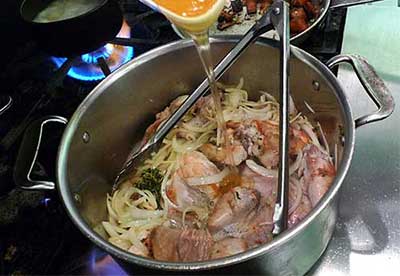
Slow Cooking the Rabbit or Hare
One of the easiest and surefire ways to produce delicious cooked rabbit and hare is to slow cook it overnight in a dutch oven. You don’t need to worry about quartering up the rabbit or hare, although you’re more than welcome to.
Place the rabbit and/or hare into the dutch oven and any vegetables you like to cook along with them. Potatoes, carrots, and onions are always a good standby. Cubed parsnips are radishes also a good option as their sharper tastes blend well other vegetables.
I like to add cubed potatoes, parsnips, and onion. It makes for a simple side dish that compliments the meat and one that my kids never argue about eating.
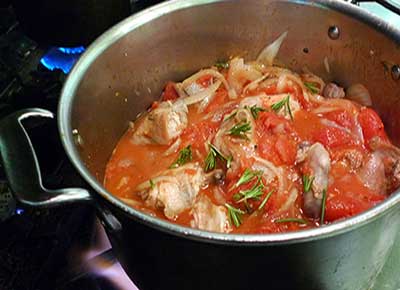
Add enough water to cover all of the vegetables and meat. Place the lid securely on the dutch oven to keep the moisture in. You can bake this in your oven at a relatively low heat (about 350 degrees) overnight or longer. You can also cook this over a small fire or bury it in the glowing coals of your supper cook fire, placing it to the side when you rekindle your fire for breakfast, and then burying back in the coals to gently cook until suppertime.
When finished, the meat will be extremely moist and tender and should be falling off the bone. A slotted spoon will help you to scoop out the vegetables and get all the meat that has loosened itself and dropped to the bottom of the dutch oven. A little salt and pepper to your vegetables are all that’s needed to make this a complete meal.
Smoke Curing
This a great way to preserve meat and makes a finished product reminiscent of jerky. While it does work for rabbit, you’ll find better success (and that it generally just works faster) with hare.
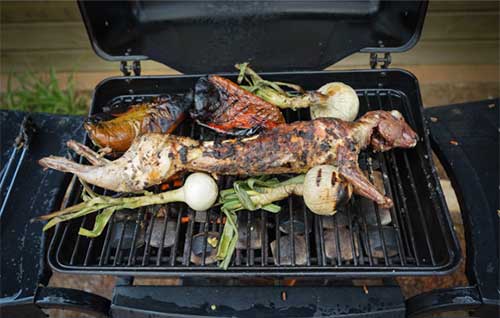
You’ll need to strip all of the meat off of the rabbit or hare, keeping the meat in as large of pieces as you can. With hare, you’ll find that you can nearly get some good sized steaks off of the back and legs.
Once you’ve got the meat all stripped off of the bones, you can either immediately cure it or season the meat. There’s an endless amount of options here. A good sprinkling of salt will help the meat cure faster and bring out the natural flavor, while allowing the meat to marinate overnight in soy sauce, barbeque sauce, or a combination of spices and vinegar will produce a variety of flavors.
This method only works with an actual fire. I’ve done it both over an open fire outside and over a rocket stove used for heat inside my camper. There was no discernable difference in taste between the two methods. Although, curing over the rocket stove did take longer and a totally benign white food mold did appear on some of the meat. Should this happen, there’s no need to toss the meat as it is a similar mold to that which makes cheese. It does you absolutely no harm to eat and does not impact the taste. Just brush it off and move on.
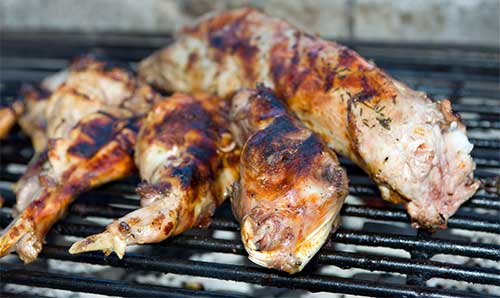
The meat will need to be suspended above the flames so that the heat and smoke alone reach it. You can do this with a metal grate or by stringing a clothesline or wire above the flames and using clothes pins to suspend the meat from the line. If you use a grate, you will need to flip the meat over at some point.
Finished cured meat will be firm and dry on the outside, though the meat will be somewhat pliable. At the center, the meat will be somewhat moister, but will in no way be juicy. This meat is a great treat to take with you when hunting or just another great way to increase your long term food stocks. You can rehydrate the meat by cooking it slowly in water (such as in your trusty dutch oven) as part of a stew or roast.
Cooking Rabbit and Hare Conclusion
When it comes to trying rabbit or hare meat, don’t let the negative comments of people who’ve never tried the meat fool you!
Both rabbit and hare are delicious and flavorful meats that are extremely moist and tender with proper cooking. They’re also versatile meats that you can roast, add to stews and pot pies, or bread and fry up. Best of all, you’ll get the satisfaction of catching them yourself and handling them from start to finish. That kind of independence brings its own satisfaction and is one the greatest things about cooking and eating game that you personally provided.